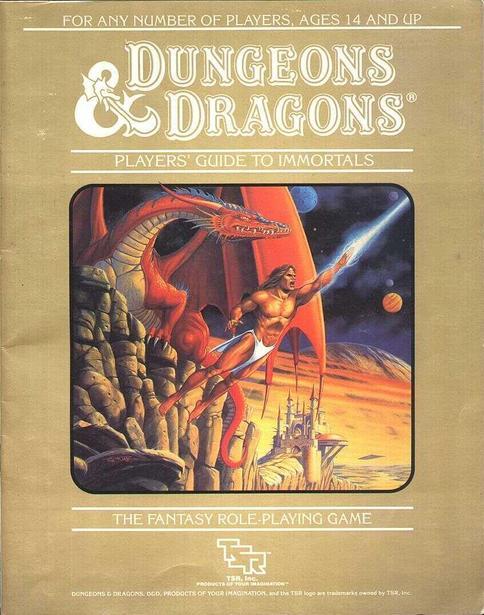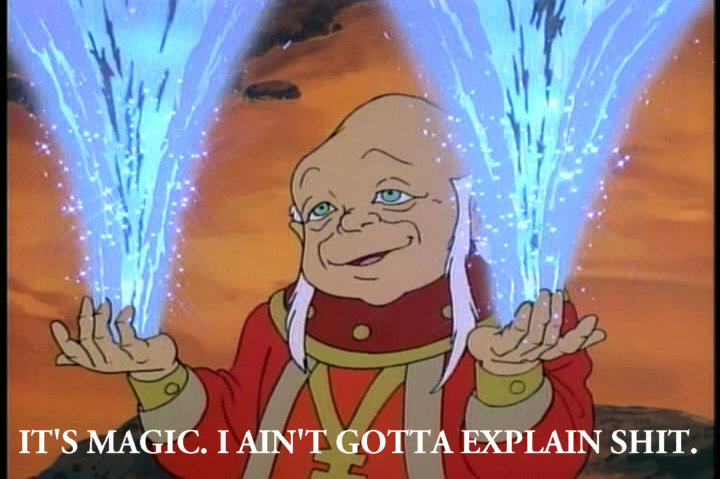Players' Guide to Immortals by Mimir
What's it about?
Original SA post You got your Nobilis in my Dungeons and Dragons! Yeah, well, you got your Dungeons and Dragons in my Exalted! (In 1986)Have you got all the levels? Has your group of mid-80’s players killed more than enough dragons to literally last a lifetime? Do you have a ready collection of Artifacts and Magic Items you might be willing to pawn to a godlike creature in exchange for a shot at power and immortality?
If so, then perhaps the time has come to no longer worry about lifetimes. Perhaps it is time to no longer worry about the concerns of the flesh. Perhaps it’s time to read Dungeons and Dragons Immortal Rules , which covers the level where you transcend your mortal shell to become a godlike being of pure thought. That one comes right after 36. We'll also cover the later Mystara supplement Wrath of the Immortals , which is a revision and reprint of the same.
Look at how metal this cover is:

Pictured: A loinclothed man shooting lightning out of his hands, while being friends with a dragon. A space castle and space planets lie in the background. What a hyperspatial-badass/weirdo. Previous covers in the BECMI series feature:
Basic : A viking fighting a Red Dragon with sword and shield in a dungeon.
Expert : A viking on horseback fighting a Bronze Dragon with a sword and shield in the wilderness.
Companion : A man in sensible plate armor fighting a Green Dragon with a glowing sword, with a castle in the background.
Master : A badass king riding a Gold Dragon by holding on by it’s fur, with a city and landscape far below. He appears to be using a sword as a riding crop, and he wears a crown and flowing kingly cape. What a badass.
Cover analysis: Dragons just want to be your friends. Be friends with them and maybe gain vast magical power.
These rules originate is from the same line that brought us Basic D&D, and the Red Box that Wizards redid for Fourth Edition a little while back. The first one was designed was designed to introduce players to the game, with large-font text and clear instructions. We're way past that point now. The sets continued on, through four more boxes, of increasing complexity. Note that while the first three books are Suitable For Ages 10 And Up, the Master Rules necessitate an age of at least 12, and Immortal Rules require that you be 14 to play. There's an assumption that the only people who are going to use this product are those who have already been playing through a pretty long campaign. Probably a four year one. Which might've limited sales a bit.
The Basic Set was levels 1-3, Expert Set levels 4-14, Companion Set, 15-25, and Master Set, 26-36. The BECMI rules were later compiled in the Rules Cyclopedia, which is alreadu being reviewed here. That book only covered the first four Boxed Sets, leaving the Immortals Rules for a 1991's Wrath of the Immortals. Why? Because the Immortal Rules went beyond levels entirely, and also probably page count was a factor. Except actually Immortal Rules had a different kind of levels, which we’ll get into later.
What’s it about?
It’s about playing as a god. Much like in Scion, Exalted, or Nobilis, Immortals can throw around a whole lot of magical power . They can cast spells whenever they want, with a few limits. They can cast spells like a Clerid, Druid, or Magic-User. They can shapeshift and go incorporeal, throw planets around, and terrify puny mortals with their aura. They are entirely immune to mortal magic and almost entirely immune to their nonmagical attacks. They would be broken, if they cared about the regular rules at all.
They fight thirty miles long brain worms, planets, and Death itself.
But for all that, there’s a glaring omission in Immortals. See, as much as It’s about playing as a god, and as it happens, advertising a game that allows you to play as a god in 1986, at the height of the Dungeons and Dragons satanic craze was a bad idea. So despite the fact that Immortals are the beings of godlike power, who are (sometimes, debatably) guys that grant clerics their power, and who they worship and it is noted in the text that "In the rare cases when they are indiscreet, mortals often may think them to be gods." They aren’t gods, we swear. Playing an Immortal as they are described is often closer, in a sense, to playing this guy.

Because of the ban on religious references, the Immortal Rules have no stats or reference to any gods or myths, or indeed any stats for any NPC immortals at all. No Zeus, no Thor, not even Pflarr or Rad. It does have stats for Orcus and Demogorgon though, which says a lot about TSR's tact. Wrath of the Immortals fixes this, with a whole section on the
Lastly, before I dive in, I’d like to note that while I’m not the most familiar with these two books, I was pretty amazed by the 3.0 Epic Level Handbook when I was younger, which is worthy more than of a full write-up both here and in the Murphy’s Rules thread. I also got my hands on a PDF of the Immortal Bestiary which my much younger self thought it was cool in a hyperinflationistic sort of way, and which was covered a bit in the last thread. It turns out that, unbeknownst to me, those two books were taking their fluff out of Immortal’s playbook, but in an OGL context, with a much larger number of dice. Everything neat about those two books makes much more sense in light of this one.
Or possibly much less sense.
I’m not sure.
Next time: Prefaces! Descriptions of spheres! OVERVIEWS!